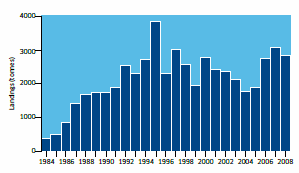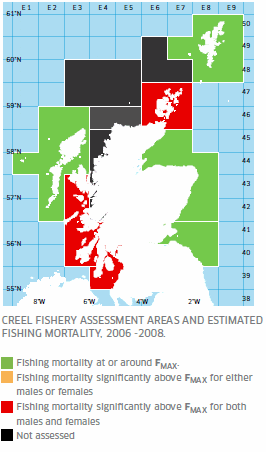Introduction
With the collapse of the Spanish fishery in the early 1980s the Scottish fishery expanded rapidly to supply southern European markets, and became the largest velvet crab fishery in Europe. In 2008, the fishery landed 2,800 tonnes of velvet crab into Scotland with a value of £6.1 million. Velvet crabs are caught in the inshore creel fishery along with lobster and brown crab. Very few fishermen fish solely for ‘velvets’. Previously the fishery was associated mainly with the west coast (Hebrides and South Minch assessment areas) and Orkney, but since 2002 landings on the east coast of Scotland have increased substantially. It is not clear whether this is due to an increase in the population in this area or to more specific targeting of the species. In 2008, the majority of landings came from Orkney, South Minch, East Coast, Hebrides and South East areas. Most velvet crab are landed between July and November.
Biology and life cycle

The velvet crab is a member of the family Portunidae (swimming crabs) and is found in waters all around the British Isles. It is a fast moving and aggressive species, most commonly found on rocky substrates down to depths of about 25 m. Velvet crabs feed on both animal and algal material, with brown algae being the dominant item found in gut content analysis.
Females grow more slowly and to a smaller maximum size than males, differences which are likely to be due to reduced growth during the females egg bearing phase. Growth is highly seasonal and males and females moult at different times of the year; the main moult for males is between April and July, whereas females moult between May and August. Velvet crab typically live for four to six years and recruit to the fishery at around age three (65 mm CW).
They reach maturity at a carapace width of approximately 40 mm (approximately 1.5 years), although size at maturity varies according to location. This may reflect differences in water temperature or other factors such as population density, genetic makeup and fishing pressure. Mating occurs after females have moulted, when their shell is still soft. Fecundity studies carried out in Orkney and Shetland have shown estimated fecundities (numbers of eggs produced) ranging from 5,000 to 278,000 per female. In contrast to brown crabs, velvet crabs are not thought to undertake extensive migrations and rarely move further than a few hundred metres.

Management advice

The velvet crab fishery is not subject to EU TAC regulations or national quotas. In Scotland, vessels landing velvet crab are required to have a licence with a shellfish entitlement. Vessels without this entitlement are only allowed to land limited amounts (25 crabs per day). The main regulatory mechanism is a minimum landing size of 65 mm CW in all areas except Shetland (70 mm CW, under the Shetland Regulating Order)
Assessment
Age determination is generally not possible for animals which moult and application of agestructured assessment methods to crustacean stocks is problematic. Length Cohort Analysis (LCA) is the method used for assessing brown crab stocks. It uses official landings and length frequency data collected as part of the Marine Scotland Science market sampling programme. LCA results are calculated in terms of yield-per-recruit and biomass-per-recruit relative to changes in fishing mortality. This provides a framework for evaluation of management measures.
Assuming a direct relationship between fishing mortality and effort, generally lower levels of fishing effort will result in an increase in stock size and a reduction in landings. A higher level of fishing effort will reduce total stock biomass but landings may also fall, as animals are caught before they have had time to grow to a size that would contribute much weight to the yield (growth overfishing). In between these lies FMAX, the fishing mortality rate that maximises yield-per-recruit. The changes that the LCA predicts are long-term (equilibrium). The method does not provide any indication of shortterm stock dynamics or recruitment over-fishing. Assessments are performed on a regional basis for males and females separately.
State of the stocks

Results of assessments based on LCAs for the period 2006-2008 for seven of the twelve assessment areas, summarising estimates of fishing mortality in relation to the reference point FMAX, are shown on the map (see p59). There were insufficient sampling data from the Mallaig, Ullapool North Coast, Sule and Papa areas to conduct LCAs. Of the assessed areas, velvet crab stocks in the Hebrides, Shetland, East Coast, and South East were fished at approximately FMAX whilst both male and female stocks in Clyde, Orkney and South Minch were fished at levels significantly above FMAX.
Management advice
Overall, assessments for the period 2006-2008 show that most velvet crab stocks in Scotland are being fished close to or above FMAX, which is above optimum effort level to achieve the maximum yield-per-recruit. In some assessment areas, a higher yield and biomass-per-recruit in the long term could potentially be obtained by reducing the level of fishing mortality (effort).
June 2010
